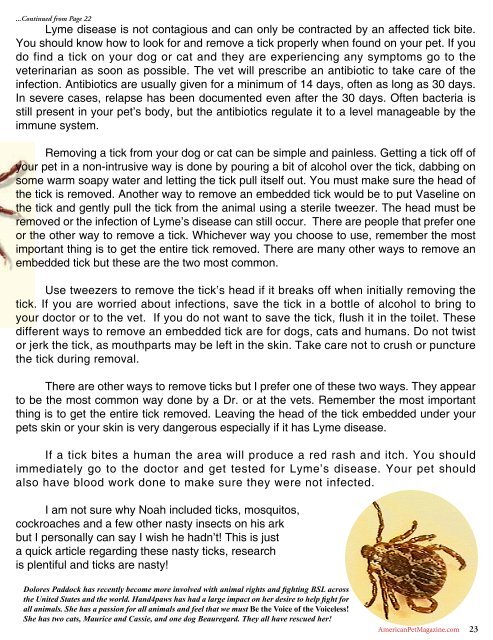V2_Issue2
V2_Issue2
V2_Issue2
You also want an ePaper? Increase the reach of your titles
YUMPU automatically turns print PDFs into web optimized ePapers that Google loves.
...Continued from Page 22<br />
Lyme disease is not contagious and can only be contracted by an affected tick bite.<br />
You should know how to look for and remove a tick properly when found on your pet. If you<br />
do find a tick on your dog or cat and they are experiencing any symptoms go to the<br />
veterinarian as soon as possible. The vet will prescribe an antibiotic to take care of the<br />
infection. Antibiotics are usually given for a minimum of 14 days, often as long as 30 days.<br />
In severe cases, relapse has been documented even after the 30 days. Often bacteria is<br />
still present in your pet’s body, but the antibiotics regulate it to a level manageable by the<br />
immune system.<br />
Removing a tick from your dog or cat can be simple and painless. Getting a tick off of<br />
your pet in a non-intrusive way is done by pouring a bit of alcohol over the tick, dabbing on<br />
some warm soapy water and letting the tick pull itself out. You must make sure the head of<br />
the tick is removed. Another way to remove an embedded tick would be to put Vaseline on<br />
the tick and gently pull the tick from the animal using a sterile tweezer. The head must be<br />
removed or the infection of Lyme’s disease can still occur. There are people that prefer one<br />
or the other way to remove a tick. Whichever way you choose to use, remember the most<br />
important thing is to get the entire tick removed. There are many other ways to remove an<br />
embedded tick but these are the two most common.<br />
Use tweezers to remove the tick’s head if it breaks off when initially removing the<br />
tick. If you are worried about infections, save the tick in a bottle of alcohol to bring to<br />
your doctor or to the vet. If you do not want to save the tick, flush it in the toilet. These<br />
different ways to remove an embedded tick are for dogs, cats and humans. Do not twist<br />
or jerk the tick, as mouthparts may be left in the skin. Take care not to crush or puncture<br />
the tick during removal.<br />
There are other ways to remove ticks but I prefer one of these two ways. They appear<br />
to be the most common way done by a Dr. or at the vets. Remember the most important<br />
thing is to get the entire tick removed. Leaving the head of the tick embedded under your<br />
pets skin or your skin is very dangerous especially if it has Lyme disease.<br />
If a tick bites a human the area will produce a red rash and itch. You should<br />
immediately go to the doctor and get tested for Lyme’s disease. Your pet should<br />
also have blood work done to make sure they were not infected.<br />
I am not sure why Noah included ticks, mosquitos,<br />
cockroaches and a few other nasty insects on his ark<br />
but I personally can say I wish he hadn’t! This is just<br />
a quick article regarding these nasty ticks, research<br />
is plentiful and ticks are nasty!<br />
Dolores Paddock has recently become more involved with animal rights and fighting BSL across<br />
the United States and the world. Hand4paws has had a large impact on her desire to help fight for<br />
all animals. She has a passion for all animals and feel that we must Be the Voice of the Voiceless!<br />
She has two cats, Maurice and Cassie, and one dog Beauregard. They all have rescued her!<br />
AmericanPetMagazine.com 23


